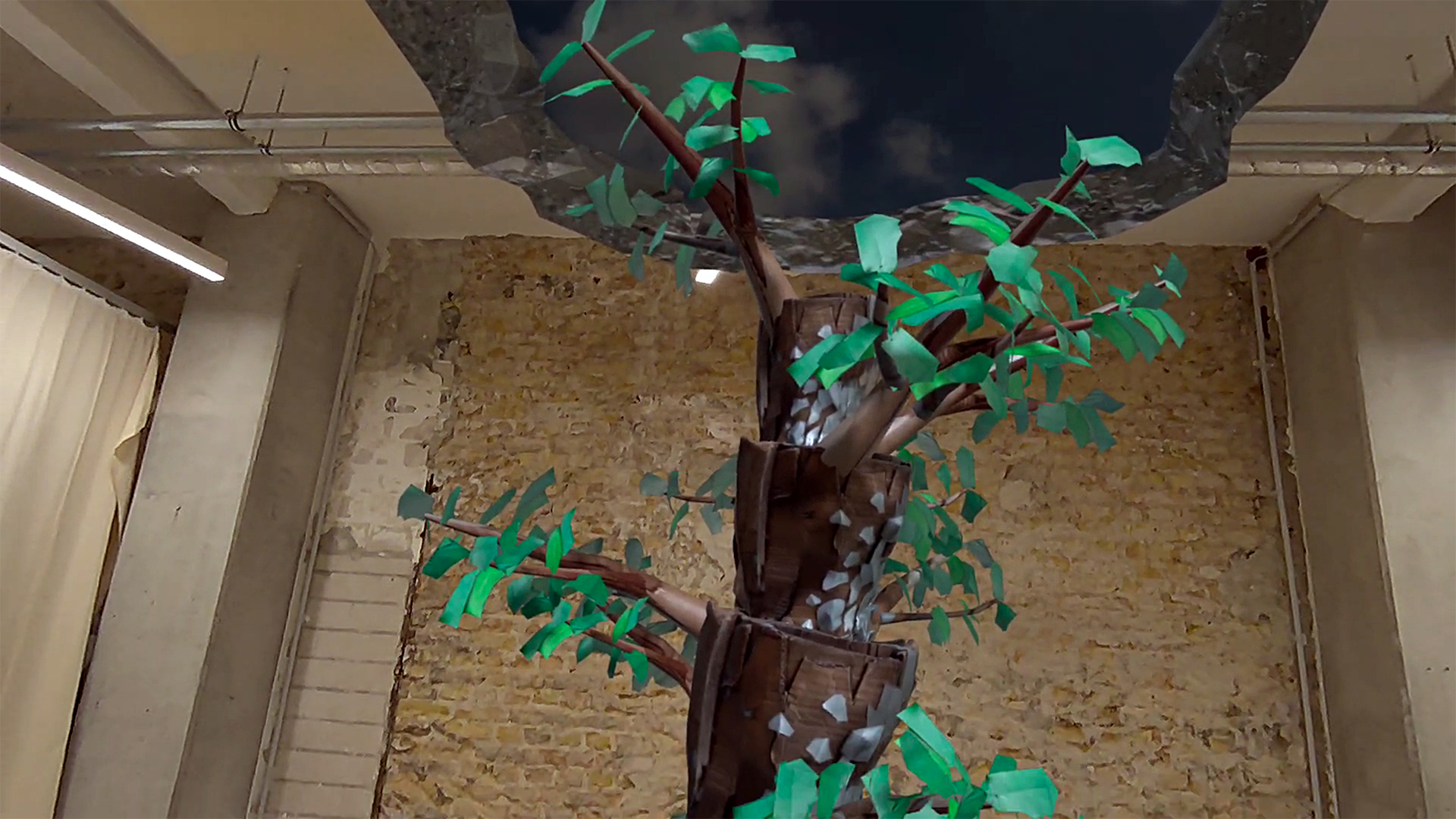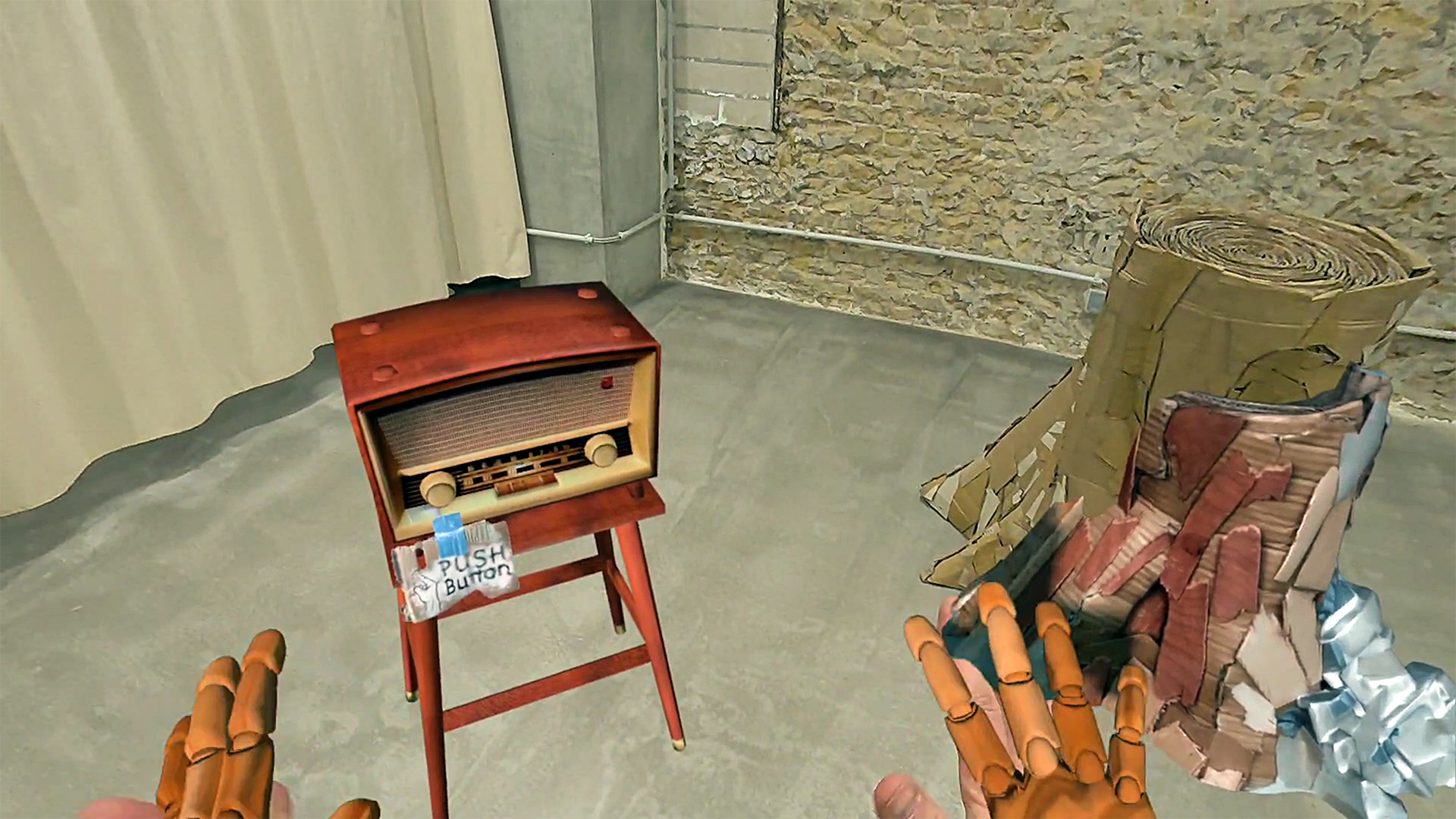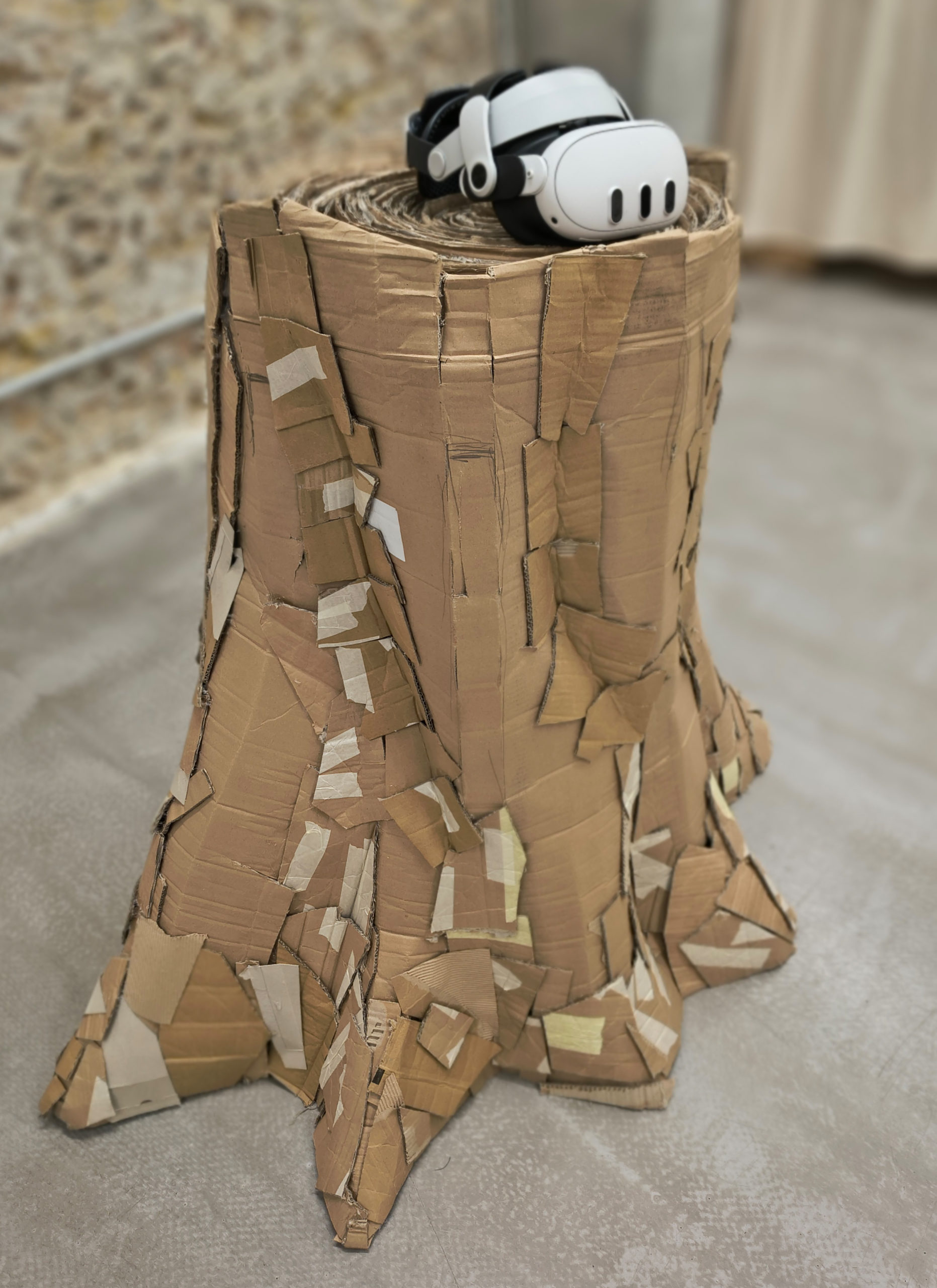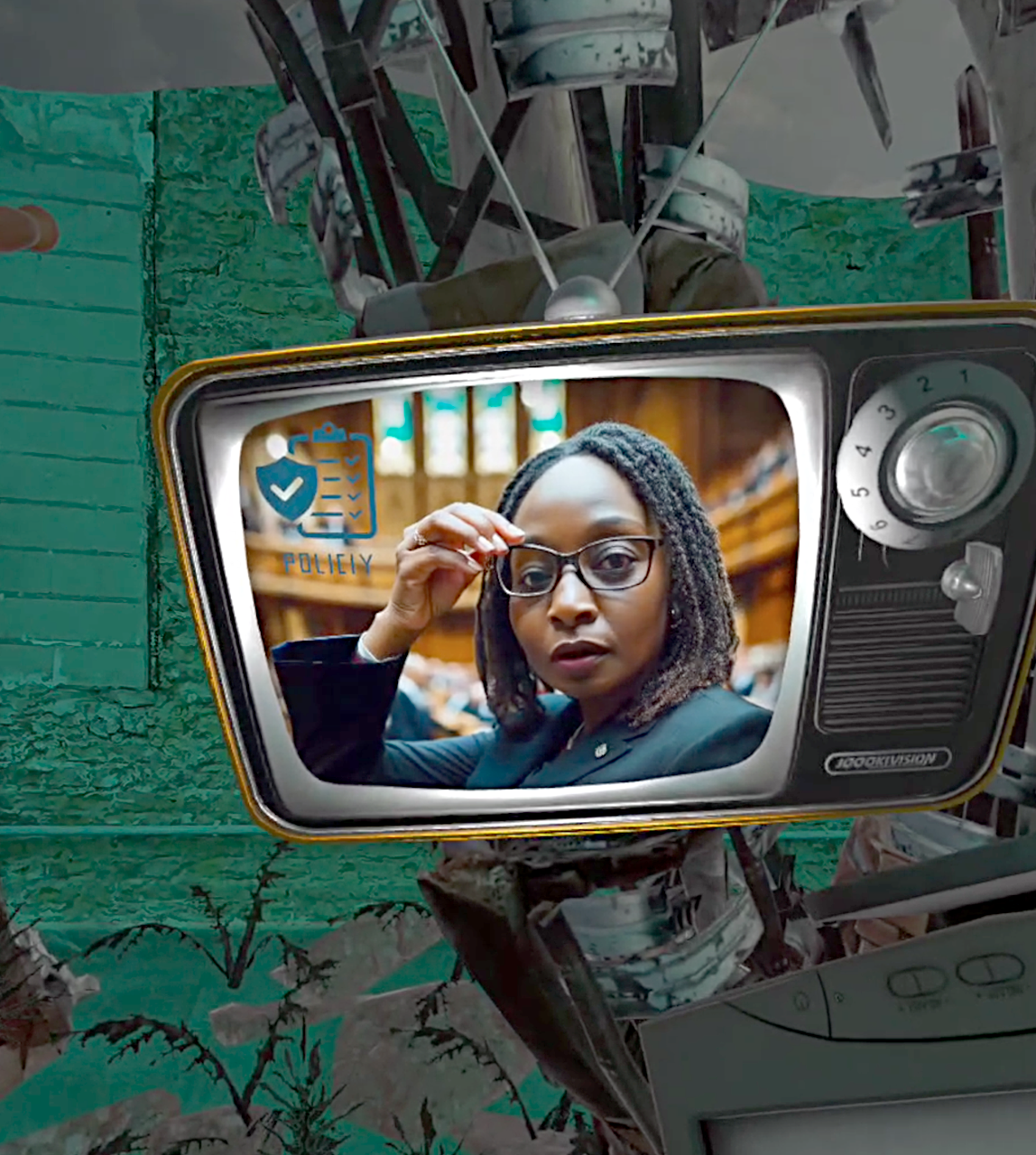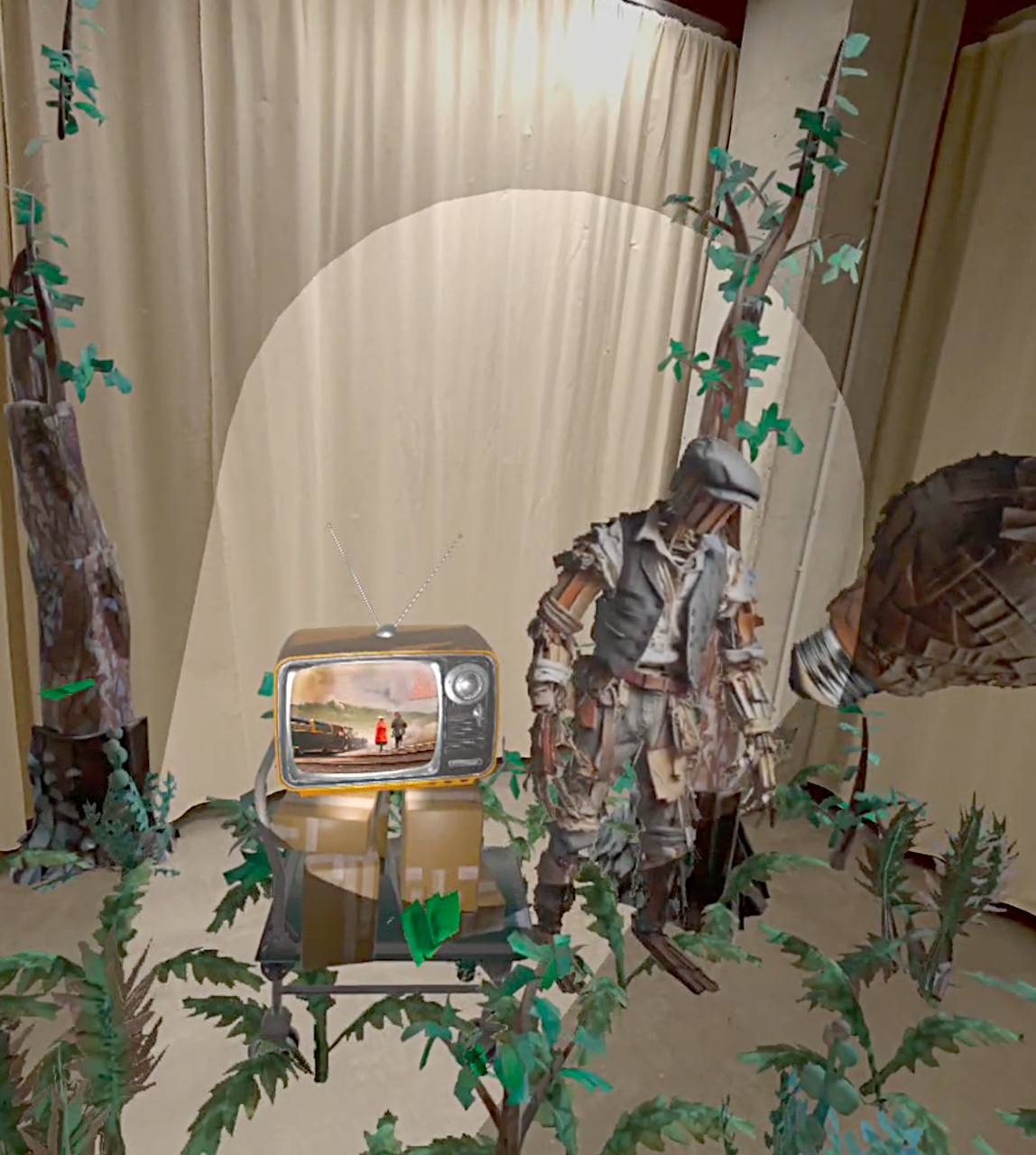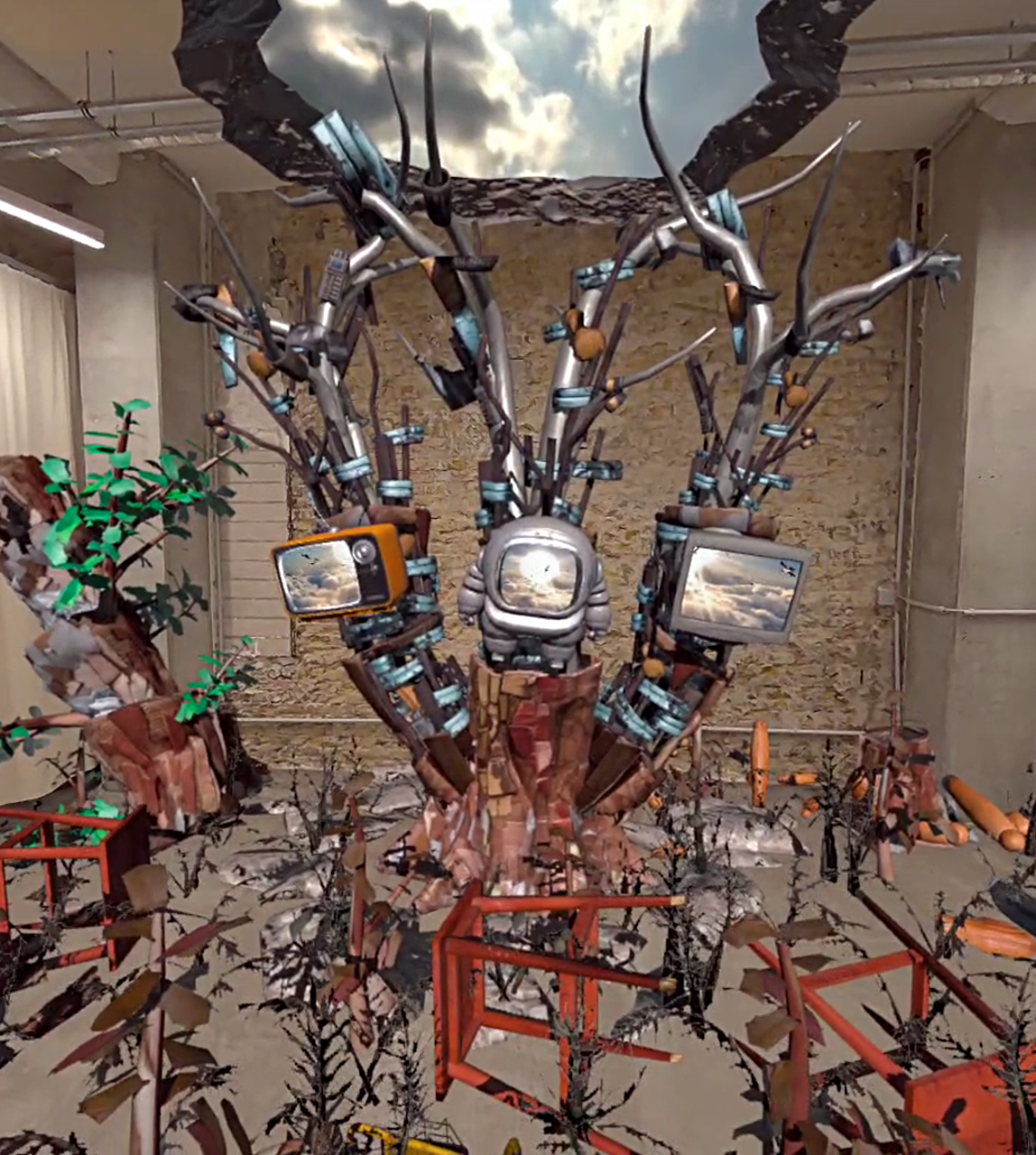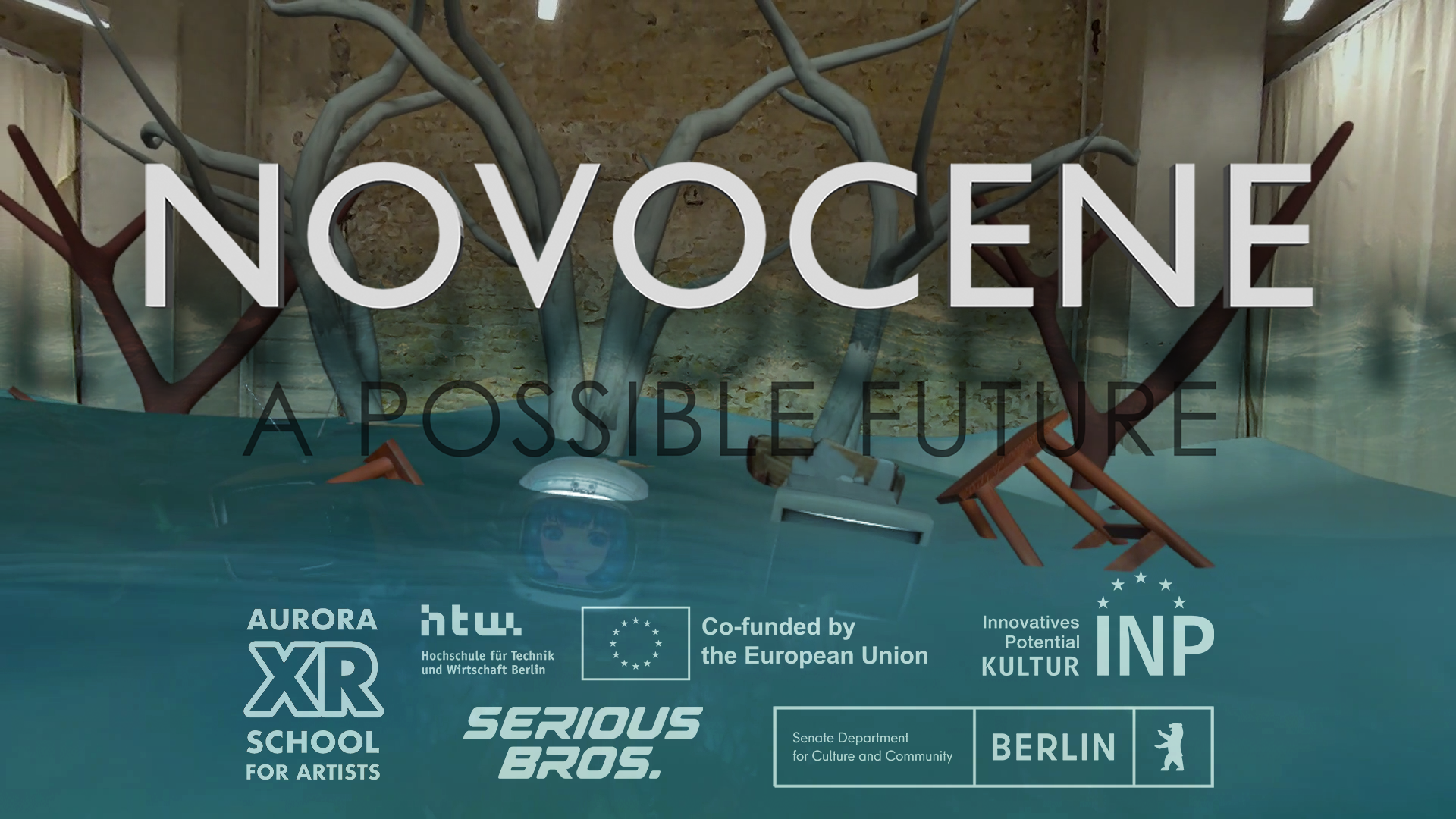
Interactive Mixed Reality Installation
Quest 3 MR headset and analog tree sculpture
Novocene unfolds as an interactive narrative exploring humanity’s evolution through the Anthropocene—an era defined by human impact, resource extraction, and environmental devastation. Contrasting the realities of ecological destruction with visions of technological utopia, the work immerses viewers in a reflective journey through time and possibility.
The focus of attention is an analogue tree stump around which the plot evolves. When the viewer puts on the MR headset lying on the sculpture, the stump grows back virtually and transforms into a living organism. In the end even the climate crisis becomes tangible as the physical exhibition space appears to submerge beneath a rising, 3D-rendered sea level, making the consequences of environmental transformation viscerally present.
This condensed odyssey through a human-shaped epoch interrogates the promises and perils of technological progress and artificial intelligence in addressing the planet’s most pressing crisis. Novocene poses a critical and poetic question: can art and aesthetics grasp, let alone respond to, a phenomenon as vast and complex as the climate emergency?
Trailer and Video Footage
( Please note: the captured image quality can hardly reproduce the immersive 3D illusion )
More about the work
- German Description
- Intention and Motivation
- Literature and Research
- Collaboration and Funding
- The Use of AI Tools
- Novocene – Abstract – 2 Pages PDF
- Novocene – Research Paper – 8 Pages PDF
- Novocene – Installation Package – APK
( A Quest 3 in developer mode is required for installation )
Intention and Motivation for the Project
The interactive experience thematizes human impact on nature and inevitably leads to the question: Is it even possible to deal artistically and aesthetically with something as colossal as the climate crisis and its destructive consequences? How can the narrative of the possible end of all narratives succeed? Is it possible to strike a fine balance, hopefully somewhere between instruction and fatalism on the one hand and naïve ignorance and faith in technology on the other? Critical voices from the field of neuroscience tend to deny that humanity, in its subjective constitution, is capable of processing a challenge of such complexity and temporal horizon at all. Another prominent thesis is based on the imprint of the evolutionary pressure to adapt. According to this theory, egoism steeled by competition thwarts collective, global action. Consequently, the hope remains that we will develop the ability for this action as soon as possible.
In the beginning the essayistic journey through time takes its recipients back to the untouched natural state of the Holocene, shortly before humans began to exert their global influence. The audiovisual excursion goes on to describe the onset of the soon unbridled exploitation and burning of natural resources. The title Novocene is a homage to the environmental philosopher James Lovelock, who as a scientist was also involved in the discovery of the hole in the ozone layer. He saw the aforementioned human dilemma being solved in a future age of hyperintelligence, which he outlined in his popular science book Novacene (2019).
A Critical Look at the role of Technology
The expectations of hyperintelligence are particularly topical in the context of the current hype surrounding so-called artificial intelligence. Critics see AI as the direct heir to the throne of blockchain and NFTs as the currently trending technological promise of salvation. Paradoxically, it contributes to real environmental problems primarily through its inflationary energy consumption and the resulting escalation in emissions – a conflict that is reflected in the development process of this project, in which Jens Isensee has increasingly resorted to interesting and useful AI tools to generate textures, objects, voice output, characters and even 3D objects. Whether this results in a new, visual identity for the work or a generic aesthetic that quickly overtakes itself remains an unresolved contemporary conflict, which is inevitably reflected in Novocene. Devices such as radio, television, monitor and a chatbot are located in the virtual space like representatives of media evolution and drive the plot forward with interspersed announcements and broadcasts. Here, belief in progress and media development go hand in hand. In the end, the devices come together to form a kind of slot machine that spits out solutions that counteract patterns and clichés.
Are we experiencing an abbreviated representation of well-known facts or rather the limits of media production represented by the cited medium of video games? It is mostly hard to follow the red line of narration and one could easily get the idea that the nested levels of action and time in this mixed reality experience reveal the narrative style of our time that has fallen prey to spectacle. In any case, the visual experience invites an in-depth examination of the intention of the work and its sources. Novocene aims to explore the immersive and activating potential of mixed reality hardware and interactive 3D engines, which is often talked about as a way of awakening empathy for the state of the earth. As a philosophical reflection, the work aims to stimulate the idea of a global sense of responsibility and to emphasize the urgency of action. Despite the unmistakable facts about the deplorable state of affairs in both the analog and virtual worlds, the source of the impetus to take decisive action against humanity’s crisis remains an unsolved and exciting mystery.
The use of AI tools in the installation
To create the visual environment, various AI solutions were used to generate image, video and sound material, as well as to create 3D models. They became increasingly important as the project progressed and the scope of the project grew. The significance of these new technical options for artistic work also reflected into the thematic dimension of the work, shaping the narrative and its final statement. The screens of the technical devices ultimately proclaim to the viewer a solution to environmental and climate problems, while paradoxically he is surrounded by nature that has been completely deforested and devastated and the felled tree has been replaced by a technical construction. The critical countering of technical development thus became the central motif of the immersive installation.
Some of the interaction objects, such as the tree stump and the watering can, were modeled and constructed in analog form and then photographed from all sides using the AI-supported smartphone app Kiri-Engine and automatically converted into 3D models that require hardly any post-processing. To create the chat bot model, the AI solution Hunyuan3D-2 from Tencent was used, which creates a complete 3D model from one or more images. The required image templates were first created using the image generators of Adobe’s Photoshop, Midjourney and ChatGPT’s Dall-E 3. Here, the artist first carried out an experimental style development and compared the different methods to generate figure designs, but also plants and textures. This visual material was also used in the videos, which can be seen on a number of screens and televisions in the plot and essentially drive the narrative forward. In Runway faces and people were animated and made to speak or various image-based action scenarios were generated. In the case of the narrative characters, their texts were first set to music using Elevenlabs.io.
Links and Literature
Jens Isensee creates his art not least in order to structure his insights and develop new ideas in the process of their realization. He sees accompanying texts as part of the body of work. Many trains of thought and narrative threads in this work are interpretations and collages of excerpts and fragments from books read in context. For the realization of Novocene, he credits the anthology Interspecies Future (2014) by the LAS Art Foundation and its authors as his main inspiration. Men who burn the world, Männer, die die Welt verbrennen (2024), by Christian Stöcker sharpened the final certainty that we are sacrificing the future of our living world to the profits of a vanishingly small minority. From Thomas Metzinger’s Culture of Consciousness, Bewusstseinskultur (2023), he took the astute analysis of the world situation and that it is now nothing more than an act of intellectual dishonesty not to name the actual catastrophe as such. There was also a lot on how we could develop a new consciousness in New Radical Enlightenment: Philosophy for a Common World (2024) by Marina Garcés.
Novocene is a Collaboration with
Aurora XR School for Artists | Hera Project | HTW Berlin

Novocene was selected by the XR Open Call jury of HTW Berlin’s AURORA XR School for Artists in April 2024. As a result, it is now being developed in close collaboration with HTW’s interdisciplinary project team, with co-funding from the European Regional Development Fund under the INP-III program and the kind support of the Senate Department for Culture and Community.
Novocene – Eine mögliche Zukunft
Interaktive Mixed Reality Installation
Quest 3 MR-Headset und analoge Baumskulptur | 5 x 5 m
Das Novozän entfaltet sich als interaktive Erzählung, welche die Entwicklung der Menschheit im Anthropozän beleuchtet – eine Epoche, die von menschlichen Einflüssen, Ressourcenausbeutung und ökologischer Verwüstung geprägt ist. Kontrastiert wird die Realität der Umweltzerstörung mit technologischen Utopien, welche die Betrachter auf eine Reise durch die Zeit und in mögliche Zukünfte mitnehmen.
Im Zentrum der Aufmerksamkeit steht ein analoger Baumstumpf, um den herum sich die Handlung entwickelt. Setzt der Besucher das auf der Skulptur liegende Mixed-Reality-Headset auf, wächst der Stumpf virtuell nach und verwandelt sich in einen lebendigen Organismus. Am Ende wird selbst die Klimakrise erfahrbar, wenn der physische Ausstellungsraum unter einem ansteigenden, 3D-gerenderten Meeresspiegel versinkt.
Diese ca. acht minütige Odyssee durch eine vom Menschen geformte Epoche hinterfragt die Versprechungen und Gefahren des technologischen Fortschritts und der künstlichen Intelligenz bei der Bewältigung der drängendsten Krise der Menschheit. Novocene stellt letztlich die kritische Frage: Können Kunst und Ästhetik ein kolossales Phänomen von der Größe und Komplexität das Klimanotstandes überhaupt erfassen – geschweige denn darauf eine Antwort geben?

